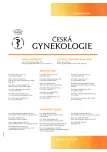Anatomy and biomechanic of the musculus levator ani
Authors:
Martin Němec 1
; L. Horčička 2; L. Krofta 3; Jaroslav Feyereisel 3; M. Dibonová 1
Authors‘ workplace:
Gynekologicko-porodnické oddělení Nemocnice ve Frýdku-Místku p. o, primář MUDr. M. Němec, MBA
1; GONA s. r. o., nestátní zdravotnické zařízení, jednatel MUDr. L. Horčička
2; Ústav pro matku a dítě, Praha-Podolí, ředitel doc. MUDr. J. Feyereisel, CSc.
3
Published in:
Ceska Gynekol 2019; 84(5): 393-397
Category:
Overview
Objective: The aim of the rewiew is to provide complex new informations about anatomy and biomechanics features of the musculus levator ani. Described are risk factors leading to it´s injury and options of imaging the muscle complex (ultrasound, magnetic imaging resonance and 3D modeling).
Design: Review.
Settings: Departement of Obstetrics and Gynaecology, Hospital in Frýdek-Místek, GONA Co. Ltd , Institute for Mother and Child Prague.
Results: Musculus levator ani (MLA) has a complex structure composed mainly of striated muscles. Minority of smooth muscle fibres are also found. Particular parts of the MLA hold together different angles. Inervation is provided through somatic and visceral nerve fibres. During delivery, more there three times stretching of the muscle was observed. Less strenght is needed do the same stretching of the muscle in repeating stress situations. In the MRI studies, two types of injury of the MLA, were found. Predisponed to the injury is medial part of the MLA known as pubovisceral muscle (PVM). PVM has three insertions. The most fragile is it´s medial insertion to the pubic bone described as enthesis. During experimental delivery studies was found, that the pressure in this part of the muscle reach almost 36MPa.
Conclusion: MLA is a difficult muscle. Because of the ethical reasons we don´t have, and probably never will have informations, how structuraly and elasticaly differs muscle, that was damaged during the delivery, compared to muscle without any damage. Promising are computer delivery simulations. In future, they would give us an answer, how risky is vaginal delivery in concrete expectant mother.
Keywords:
musculus levator ani – Anatomy – biomechanics features
Sources
1. Ashton-Miller, JA., DeLancey, JO. Functional anatomy of the female pelvic floor. Ann N YAcad Sci, 2007, 1101, p. 266–296.
2. Betschart, C., Kim, J., Miller, JM., DeLancey, J. Comparison of muscle fiber directions between different levator ani muscle subdivisions: in vivo MRI measurements in women. Int Urogynecol J, 2014, 25, p. 1263–1268.
3. DeLancey, JO., Kearney, R., Chou, Q., et al. The appearance of levator ani muscle abnormalities in magnetic resonance images after vaginal delivery. Obstet Gynecol, 2003, 101, p. 46.
4. DeLancey, JO., Morganm, DM., Ferner, DE. Comparsion of levator ani muscle defects and function in women with and without pelvic organ prolapse. Obstet Gynecol, 2007, 109, p. 295–302.
5. Dietz, HP., Kirby, A., Shek, KL. Does avulsion of the puborectalis muscle affect bladder function? Int Urogynecol J, 2009, 20, p. 967–972.
6. Gachon, B., Desseauve, D., Fradet, L., et al. Changes in pelvic organ mobility and ligamentous laxity during pregnancy and postpartum. Review of literature and prospects. Prog Urol, 2016, 26, p. 385–394.
7. Gachon, B., Fritel, X., Fradet, L., et al. Is levator hiatus distension associated with peripheral ligamentous laxity during pregnancy? Int Urogynecol J, 2017, 28, p. 1223–1231.
8. Hinata, N., Murakami, G. The urethral rhabdosphincter, levator ani muscle, and perineal membrane: a review. BioMed Res Int, 2014, 906921.
9. Huebner, M., Margulies, RU., DeLancey, JO. Pelvic architectural distortion is associated with pelvic organ prolapse. Int Urogynecol J Pelvic Floor Dysfunct, 2008, 19, p. 863–867.
10. Kearney, R., Sawhney, R., DeLancey, JO. Levator ani muscle anatomy evaluated by origin-insertion pairs. Obstet Gynecol, 2004, 104, p. 168.
11. Kim, J., DeLancey, JO., Ashton-Miller, JA. Why does the pubovisceral muscle fail at its enthesis, and not elsewhere, during the second stage of labor? A computational study. 35th Annual Meeting of the American Society of Biomechanics, Long Beach, CA; 2011.
12. Kim, J., Betschart, C., Ramanah, R., et al. Anatomy ot the pubovisceral muscle origin: Macroscopic and Microscopic findings within the injury zone. Neurol Urodyn, 2015, 34, p. 774–780.
13. Krofta, L., Havelková, L., Urbánková, I., et al. Finite element model focused on stress distribution in the levator ani muscle during vaginal delivery. Int Urogynecol J, 2017, 28, p. 275–284.
14. Morgan, DM., Kaur, G., Hsu, Y., et al. Does vaginal closure force differ in the supine and standing positions? Am J Obstet Gynecol, 2005, 192, p. 1722–1728.
15. Němec, M., Horčička, L., Dibonová, M., et al. MRI analysis of the musculo-fascial component of pelvic floor in woman before planned vaginal reconstruction procedur for symptomatic pelvic organ prolapse].(PMID:29869505), Ces Gynek, 2018, 83(2), p. 84–93.
16. Oliphant, SS., Nygaard, IE., Zong, W., et al. Maternal adaptations in preparation for parturition predict uncomplicated spontaneous delivery outcome. Am J Obstet Gynecol, 2114, p. 630.e1–630.e7. doi: 10.1016/j.ajog.2014.06.021.
17. Rubod, C., Brieu, M., Cosson, M., et al. Biomechanical properties of human pelvic organs. J Urol, 2012, 79(4), p. 1346–1354.
18. Shafik, A., Doss, S., Asaad, S. Etiology of the resting myoelectric activity of the levator ani muscle: physioanatomic study with a new theory. World J Surg, 2003, 27, p. 309–314.
19. Shek, K., Dietz, H. Intrapartum risk factors for levator trauma. BJOGP Int J Obstet Gynecol, 2010, 117(12), 2010, p. 1485–1492.
20. Singh, K., Jakab, M., Reid, WM., et al. Three-dimensional magnetic resonance imaging assessment of levator ani morphologic features in different grades of prolapse. Am J Obstet Gynecol, 2003, 188, p. 910.
21. Timoh, KN., Moszkowicz, D., Zaitouna, M., et al. Detailed muscular structure and neural control anatomy of the levator ani muscle: a study based on female human fetuses. AJOG, 2018.
Labels
Paediatric gynaecology Gynaecology and obstetrics Reproduction medicineArticle was published in
Czech Gynaecology

2019 Issue 5
Most read in this issue
- Syndrome Mayer-Rokitansky-Küster-Hauser – uterine and vaginal agenesis: current knowledge and therapeutic options
- ERAS protocol in gynecologic oncology
- First-trimester screening for preeclampsia
- Uterine rupture during pregnancy
